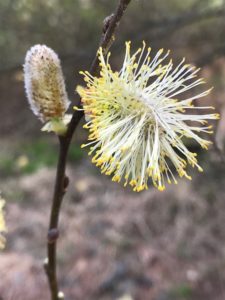Most of the year, many shrubs and understory trees can be difficult to identify, but when they bloom in the spring it’s really an easy call. Look for these three native shrubs, all of which are in full bloom right now. All are great additions to the home landscape.
Shadbush (Amelanchier canadensis)

If you are walking through the woodlands these days, you may catch sight of soft, white clouds of blooms among the gray trees. These are the showy white flower of the shadbush, a small understory tree.
The flowers give way to dark-blue berries which ripen in June. These make a delicious fruit pie if you can beat the birds to them.
In autumn, the leaves turn a brilliant red, orange and yellow.
The shadbush is easy to grow in average, well-drained soil in full sun to part shade. There are no serious insect or disease problems and there are many cultivars.
Pussy willow (Salix discolor)

One of the earliest heralds of spring with the familiar silvery-gray furry catkins appearing weeks before the leaves.
This species is dioecious – male and female flowers are produced on separate plants.
The early March catkins provide important food sources for native bees and other pollinators, which in turn creates an insect buffet for songbirds.
The Viceroy and the Mourning Cloak are two species of butterflies which use the pussy willow as a host plant.
Pussy willow can be used in the home landscape in a moist location or rain garden. It’s easy to propagate from cuttings which can be inserted in moist soil in summer. There are many colorful cultivars available.
Spicebush (Lindera benzoin)

At this time of year, a soft yellow bloom in the woods is likely to be spicebush. The dense clusters of tiny, pale yellow flowers bloom along the stems appearing before the leaves.
This shrub is also dioecious (now you know what that means!). The male flowers are larger and showier than the female ones. However only the female plants give way to the bright red fruit which matures in the fall – an attractive food source for birds. So you need both!
The leaves and stems are fragrant (smelling like Allspice), giving the plant its name.
Spicebush provides year-round interest in the landscape. Early spring blooms, summer butterflies, and bring yellow foliage in fall along with red fruit. It is pest and disease free and easy to grow in average, well-drained soils.
The Eastern Tiger Swallowtail and the Spicebush Swallowtail butterflies use spicebush as a host plant.
It’s fun to read the many stories and folktales which have been associated with this tree for hundreds of years – check it out online.

